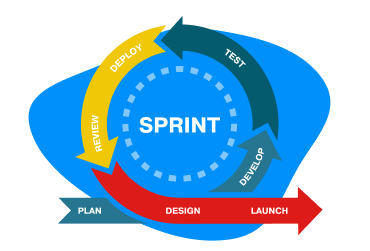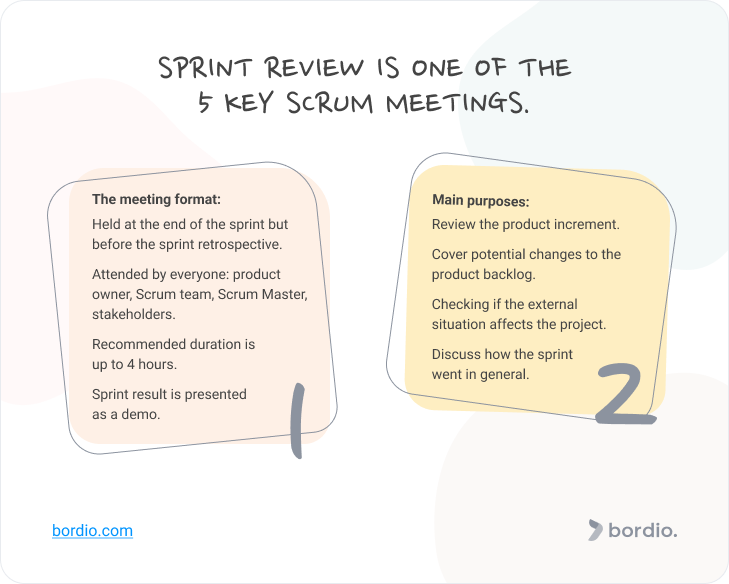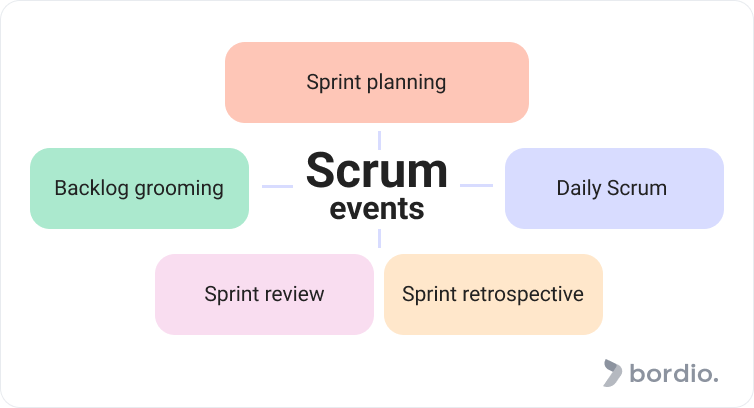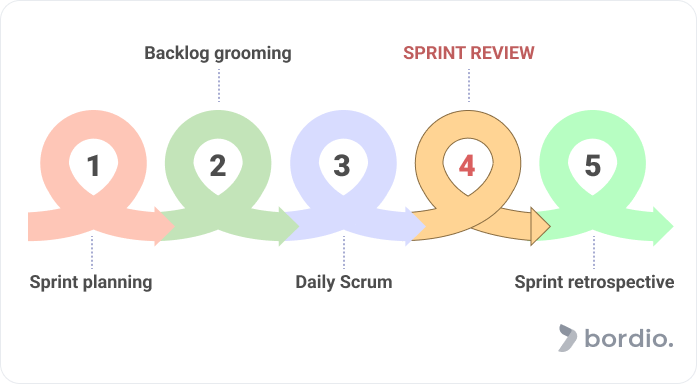Scrum is one of the most popular project management frameworks out there. It is part of Agile methodology that promotes simplicity and minimalism at work, leaving all the bureaucracies and micromanagement behind, welcoming flexibility and adaptivity.
Scrum allows for productive and efficient product delivery with the most value provided possible. It divides work into back-to-back sprints which are 2-4 week periods of time.
For each sprint, the development team thinks through the scope of work and writes it down in an online to-do list or online schedule builders. During the sprint, the team only works on those tasks to produce a product increment, also known as a potentially usable solution. When mentioning it – think of the fact that you can take the help of a remote employee management software.
To support this fast-paced value delivery, Scrum includes 5 core events(=meetings) that happen throughout the sprint. A sprint review meeting is one of those events, along with daily standup and backlog refinement, and today we will tell you all about it.
What is a sprint review?
The sprint review meeting is one of the key 5 Scrum meetings, all of which are an essential part of the Scrum Agile methodology.
Sprint review is the one before the last event during the sprint, followed only by a sprint retrospective meeting.
Sprint reviews are informal and designed to foster collaboration, gather feedback and make the end product better.
The sprint review meeting is scheduled in the team’s daily planners for the last day of the sprint to review and demo the work done in the given sprint. The main focus of the meeting is on the results of the sprint, also known as the potentially shippable product increment in the world of Scrum.
It is traditionally the role of the Scrum Master to ensure that the meeting is held and attended by all parties. Scrum Master explains the purpose and value to anyone questioning the necessity of the meeting. And it is the Scrum Master’s job to keep the meeting within the timeframes, maintain the pace, and stick to the sprint review agenda.
The sprint review format and purpose
The product owner, the development team (also referred to as the Agile team or Scrum team), key stakeholders, and Scrum Master all join the sprint review meeting.
The recommended length is up to 4 hours for longer sprints and up to 2 hours for shorter sprints that last 1-2 weeks. Otherwise, it completely takes over the team’s online planner for the day.
Only the work that was assigned to the current sprint and is considered fully done is discussed. Everything else should be dealt with outside of the sprint review. For example in the work management tool.
During the meeting, the product owner or the Scrum team presents the results they have achieved to the stakeholders.
The preferred format is the demo rather than PPT slides. Some software development teams also limit the preparation time to 2 hours maximum but it’s not a general rule.
Together all parties inspect and review the working software that is the outcome of the latest sprint. The progress towards the end project goal is discussed too. If there were any changes to the environment or internal requirements, they will also be covered during this meeting.
Many perceive the sprint review as purely a presentation but it can also serve as a place for the entire team to:
- Share feedback
- Brainstorm ideas
- Plan for the future sprints
- Exercise team building activities
However, it is important to note that there is a separate sprint retrospective meeting where the team, without the stakeholders, gets to run a deep analysis of the previous sprint in order to identify and replicate the best practices in the next sprints, and leave all the bad, not working formats behind.
There is also a sprint planning session at the beginning of each sprint. So while the team members can touch on what will be worked on next, the most scope of planning work and deciding should be left for the sprint planning meeting.
Another activity for the sprint review meeting is reviewing if anything changed in the backlog.
In case there are new opportunities or risks that came up during the sprint, they can be reflected in the product backlog too. Internal and external stakeholders can share their perspectives, talk about other products or companies with similar features and tools. The Scrum team learns what’s already on the market and how the backlog can be adjusted.
Here is a list of all things traditionally covered during a successful sprint review meeting:
- The product increment delivered in the latest sprint.
- How the sprint went in general. What bottlenecks and impediments occurred, what was good.
- The product backlog review: the current state, progress made, updates on the projected delivery date if needed.
- External factors. Have there been any changes to the market conditions, like updates from the competition, changing customer requirements, or global pandemics? How does it affect the project?
- How can the product value be maximized: ideas on what should go into the next sprint.
- General ideas for the upcoming sprint: what should be changed, added, and removed.
Sprint reviews vs retrospectives
Sprint review is held at the end of the sprint and is focused on inspecting the product increment. All project parties join and share feedback.
Retrospective is the very last event of the sprint and is held to review the sprint as a whole.
The purpose of the sprint retrospective is to facilitate continuous improvement for the Scrum team. It is attended by the team, product owner, and Scrum Master. Here, the team members review the feedback they received during the sprint review, catch up on what worked well and what didn’t, review the entire workflow to see if it can be further optimized and improved, what can be done to foster collaboration, etc. It prepares the team for the next sprint and ensures that it will be better than the last one.
If you’d like to dig deeper into this topic, then go ahead and read our Sprint Review vs Retrospective: All You Need To Know article in the Bordio blog.
And to make sure your planning and time management stay on top, try digital weekly planners and see how they change your work process for the better.
Key takeaways on sprint review
Just like Scrum in general, sprint review meetings are highly flexible and adapt to the unique projects’ needs. What your team considers a successful sprint review meeting might not be what some other team would prefer it to look like.
However, the basic guidelines were designed and tested by thousands of project teams, so it makes sense to limit the experiments and stick to the traditional setting.
So, to wrap up, let’s outline the key elements of an effective sprint review meeting:
- It is attended by everyone (product owner, Scrum team, Scrum Master, stakeholders).
- It is held at the end of the sprint and should not exceed 4 hours total.
- During the meeting, the team presents the product increment (preferably as a demo) which is then discussed.
- Additionally, topics like a to-do for the next sprint, product backlog updates, and other project-related things can be covered.








